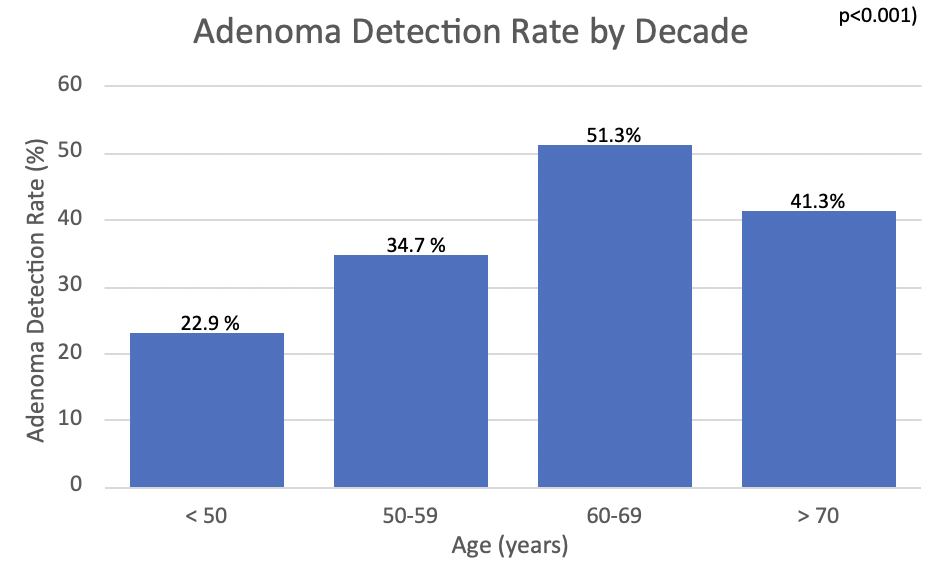Back to 2024 Abstracts
SHOULD THE ADENOMA DETECTION RATE QUALITY METRIC VARY BY AGE: AN EXPLORATORY ANALYSIS
Charmee Mehta
*, Dmitry Tumin, Michael Honaker
Surgery, East Carolina University, Greenville, NC
Background & Aims: Higher adenoma detection rates (ADR) lead to a decreased incidence and mortality from colorectal cancer (CRC). Recent updated screening guidelines recommend starting CRC screening at age 45. Data evaluating ADR with regard to patient age is limited. The primary aim of this study is to compare adenoma detection rates by age of the patient with the hypothesis that a single ADR quality metric is inadequate across all age groups.
Methods: A single institution, retrospective, observational study was designed to evaluate the primary aim. Patients 45 years of age and older undergoing screening colonoscopy were selected for inclusion. Collected variables included demographic data, presence or absence of adenomatous colorectal polyp, and if the patient was considered increased risk of developing CRC. Age was categorized by decade. Increased risk was defined as having: a personal history of adenomatous polyps, a first degree relative with colorectal cancer, inflammatory bowel disease, or previous abdominopelvic surgery or radiation. Comparisons between groups were analyzed utilizing the chi-square test of independence. Multivariate regression modeling the presence of adenomas was used to control for confounding variables. A p<0.05 was deemed a significant finding.
Results: 441 patients met inclusion criteria for analysis. There was an overall ADR of 39.5%. ADR by decade can be seen in figure 1. There was a significantly higher ADR in patients 60-69 years of age compared to those 45-49 years of age, which had had the lowest ADR (51.3% vs 22.9%; p<0.001). Sex was also associated with the presence of adenomas with males having a higher ADR than females (55.2% vs 44.8%; p=0.016). On adjusted analysis, female sex (OR 0.65 95% CI 0.44-0.97; p=0.033) and age (OR 2.59 95% CI 1.45-4.65; p<0.001) were associated with presence of adenoma on colonoscopy.
Discussion: Current colonoscopy screening metrics recommend an adenoma detection rate of 25% regardless of age. Although the ADR in the study was above this threshold, we found the proportion of patients with an adenomatous polyp varied significantly depending on decade of life. These findings suggest the age of the patient should be taken into consideration when determining the ADR quality metric. Additionally, our findings suggest that recommending screening colonoscopy start at an even earlier age may have further impact on young-onset CRC given that the incidence of young-onset CRC continues to rise.
Key words: Adenoma detection rate, screening guidelines, age

Back to 2024 Abstracts
